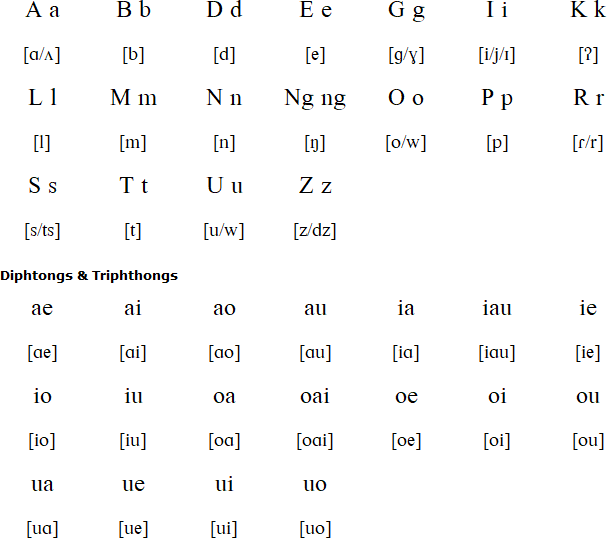Manam is member of the Western Oceanic branch of Malayo-Polynesian language family. It has about 8,000 speakers on the island of Manam (Manam Motu) in the Bismarck Sea in the Bogia District of Madang Province in the north of Papua New Guinea. It is also spoken in the nearby Boisa Islands.
Manam is a volcanic island that was evacuated in 2004 due to a major eruption. The residents were resettled in other parts of Papua New Guinea. Since then many people have returned to the island.
Manam is also known as Manum, and native speakers call it Manam Pile ("Manam Talk"). It is written with the Latin alphabet.

Download an alphabet chart for Manam (Excel)
< iraia kaiko Rupunae be Zaong ruangadiaru? Be ngau urai bokai kaiko Rupunae be Zaong kukaoa takidiaru. Be ngai bokai iraia ngau Rupunae be Zaong ukaoa takidiaru toira Bogialo usoaki nge Madanglo be dimairu be anua nem dilakoru. Mukunala kipileru itui be ialale. Izama tanepoa nge ipura be tamoata ibagabagai irangaka be moasitaki kana. Bakara tamoata nge depa robu boadiadi ibebe. Tamoata ibagabagai nge Kukukus tamoata kata. Ono boadinga emakadi ibebe bokai be kana moarunga mitikitiki kana.
' ,and he said, 'Are you a friend of Rupunae and Zaong?' And I asked, 'You know Rupunae and Zaong?' And he said to me, 'I knew Rupunae and Zaong before when I was staying at Bogia and they came from Madang and went to their place.' The two talked a little, then he stood and left. In the morning the white man came to show the man around, to introduce and care for him. Because that man didn't know how to cook rice. The man he brought was a Kukukus man. He didn't know how to use cook stoves and everything had to be taught him. The end.
Source: https://www.sil.org/resources/archives/42349
Information about Manam | Numbers
Information about Manam
https://en.wikipedia.org/wiki/Manam_language
https://en.wikipedia.org/wiki/Manam_Motu
http://olac.ldc.upenn.edu/language/mva
https://www.sil.org/resources/search/language/mva
Adzera, Ahamb, Äiwoo, Aneityum, Apma, Araki, Are, ’Auhelawa, Avava, Babatana, Bariai, Bola, Big Numbas, Buhutu, Bwaidoka, Caac, Cheke Holo, Dorig, Hiri Motu, Hiw, Hoava, Kakabai, Kaninuwa, Kokota, Kove, Kurti, Lakon, Lehali, Lenakel, Lewo, Lote, Lo-Toga, Löyöp, Manam, Marovo, Maskelynes, Mato, Mavea, Mono-Alu, Motu, Mussau-Emira, Mwotlap, Nafsan, Nahavaq, Namakura, Nanggu, Nduke, Neve‘ei, Neverver, Ninde, North Efate, Nume, Paamese, Papapana, Raga, Rotuman, Roviana, Sa, Sakao, Saliba, Siar, Sio, Ske, Sobei, Sursurunga, Tamambo, Tami, Teanu, Tigak, Tirax, Tolai, Touo, Ubir, Ughele, Uneapa, Vatlongos, Vitu, Vurës, Western Fijian, Yabem, Yapese
Languages written with the Latin alphabet
Page created: 05.09.24. Last modified: 05.09.24
[top]
You can support this site by Buying Me A Coffee, and if you like what you see on this page, you can use the buttons below to share it with people you know.

If you like this site and find it useful, you can support it by making a donation via PayPal or Patreon, or by contributing in other ways. Omniglot is how I make my living.
Note: all links on this site to Amazon.com, Amazon.co.uk
and Amazon.fr
are affiliate links. This means I earn a commission if you click on any of them and buy something. So by clicking on these links you can help to support this site.
[top]